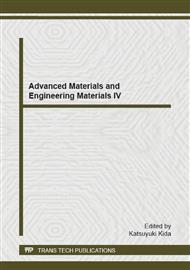[1]
L.T. Drazal, Advances in polymer science, Springer; Berlin, (1986).
Google Scholar
[2]
H.D. Middleton, Composite materials in aircraft structure, Longman, NewYork, (1990).
Google Scholar
[3]
D. Könnicke, A. Kühn, T. Mahrholz, M. Sinapius. Polymer nanocomposites based on epoxy resin and ATH as a new flame retardant for CFRP: reparation and thermal characterization, J. Mater. Sci. 46 (2011) 7046–7055.
DOI: 10.1007/s10853-011-5673-7
Google Scholar
[4]
M. S. Wang, T. J. Pinnavaia, Clay-Polymer Nanocomposites Formed from Acidic Derivatives of Montmorillonite and an Epoxy Resin, Chem. Mater. 6 (1994) 468-474.
DOI: 10.1021/cm00040a022
Google Scholar
[5]
K. Wattanakul, H. Manuspiya, N. Yanumet, The adsorption of cationic surfactants on BN surface: Its effects on the thermal conductivity and mechanical properties of BN-epoxy composite, Colloids and Surfaces A: Physicochem. Eng. Aspects 369 (2010).
DOI: 10.1016/j.colsurfa.2010.08.021
Google Scholar
[6]
J. Wang, J. Fang, C. Wang, Y. Li, M. Huang. Kinetic study of the stabilizing effect of aluminum trihydroxide on thermal degradation of epoxy resin, e-Polymers, 14 (2014) 133-137.
DOI: 10.1515/epoly-2013-0091
Google Scholar
[7]
J. Chen, Shao-Te Liu, Pao-Swu Cheng. Preparation and Characterization of Epoxy/Inorganic Anti-electrostatic Nanocomposites Using Submicrometer Al(OH)3 and Colloid Al2O3, J. Chi. Chem. Soc. 59 (2012) 975-982.
DOI: 10.1002/jccs.201100512
Google Scholar
[8]
H. Lee, B.P. Lee, P.B. Messersmith, A reversible wet/dry adhesive inspired by mussels and geckos, Nature, 448 (2007) 338-341.
DOI: 10.1038/nature05968
Google Scholar
[9]
H. Lee, S.M. Dellatore, W.M. Miller, P.B. Messersmith, Mussel-Inspired Surface Chemistry for Multifunctional Coatings, Science, 318 (2007) 426-430.
DOI: 10.1126/science.1147241
Google Scholar
[10]
M. Yu, J. Hwang, T. J. Deming, Role of l-3, 4-Dihydroxyphenylalanine in Mussel Adhesive Proteins, J. Am. Chem. Soc. 121 (1999) 5825-5826.
DOI: 10.1021/ja990469y
Google Scholar
[11]
L.P. Yang, S.L. Phua, J.K.H. Teo, C.L. Toh, S.K. Lau, J. Ma, X.H. Lu. A Biomimetic Approach to Enhancing Interfacial Interactions: Polydopamine-Coated Clay as Reinforcement for Epoxy Resin, ACS Appl. Mater. Interfaces. 3 (2011) 3026-3032.
DOI: 10.1021/am200532j
Google Scholar



